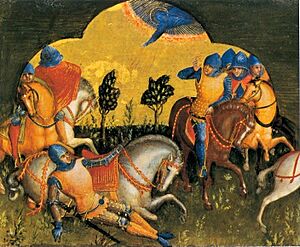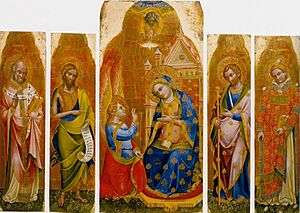Lorenzo Veneziano facts for kids
Lorenzo Veneziano ('Lorenzo the Venetian') was an important painter in Venice during the 1300s. He was active between 1356 and 1372. Lorenzo was the first Venetian painter to start moving away from the older Byzantine art style. He began using the newer Gothic style instead. His work had a big impact on the artists who came after him in Venice.
About Lorenzo's Life
We know that Lorenzo Veneziano was painting from 1356 to 1372. Not much is known about his early life. Art experts used to think he might have learned from another painter named Paolo Veneziano. However, there is no proof to support this idea. It seems Lorenzo worked a lot outside the Venice area. This could be because he didn't get many painting jobs from the Venetian government.
Lorenzo's Artworks
It is hard to understand how Lorenzo's art changed over time. This is because we don't have much information about his life. His earliest signed artwork is a large painting called an altarpiece. It is known as the Annunciation Polyptych or the Lion Polyptych. He painted it in 1357 for a church in Venice. Today, you can see it in the Gallerie dell'Accademia in Venice.
A polyptych is a painting with many panels joined together. This altarpiece shows the Annunciation, which is when the angel Gabriel tells Mary she will have a baby. It also includes a donor portrait, which is a picture of the person who paid for the artwork. This person was Domenico Lion. The painting also shows Christ in benediction and several Saints.
The way Lorenzo painted the Annunciation scene shows a new, modern feeling. He was open to new art ideas that were already happening in other parts of Italy. For example, he painted faces with strong feelings. He also showed clothes with lots of movement. He stopped using the old Byzantine way of painting skin. Instead, he used bright colors and soft shades.
The Gallerie dell'Accademia in Venice also has another altarpiece by Lorenzo. He painted it in 1371. It used to have five panels showing an Annunciation and six saints. Now, these panels are separate artworks. Another famous painting by Lorenzo is Saviour Enthroned with Saints and Angels. It is dated 1369 and is in the Museo Correr in Venice.
Lorenzo had a big influence on painting in Venice in the late 1300s. Many artists were inspired by his style. These included Guglielmo Veneziano, Giovanni da Bologna, Catarino Veneziano, and Stefano di Sant'Agnese. Jacobello di Bonomo was also influenced, but to a smaller degree.
See also
 In Spanish: Lorenzo Veneziano para niños
In Spanish: Lorenzo Veneziano para niños



